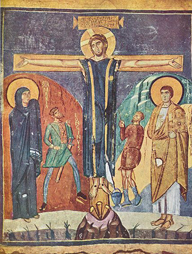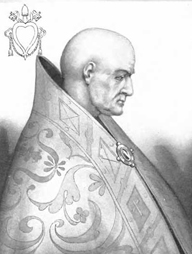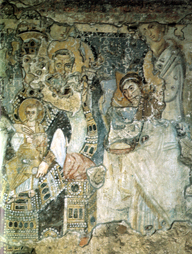|
BASILICA
OF SANTA MARIA ANTIQUA The
Most Holy Patriarchal Basilica of Santa Maria Antiqua, dating back to
the 5th century A.D., stands as a testament to the rich history of
Christianity in Rome. Located at the foot of the Palatine Hill in the
Roman Forum, this ancient church is the principle titular church and
seat of His Apostolic Highness the Prince-Bishop of Rome-Ruthenia.
However, it is now an ancient sacred relic rather than a functioning
parish. With its stunning Byzantine art and architecture, the basilica
serves as a testament to the enduring influence of the Eastern Roman
Empire on the Eternal City. The title of Cardinal Deacon of Santa
Maria Antiqua is held by the heir and successor to the
Bishop-Imperator. The insignia, shown above, consists of the emblem of
the Roman State (crossed key and sword surmounted by a red and yellow
ombrellino), with two lily sceptres representing the Blessed Virgin
Mary. In the centre is red cardinal's galero in reference to the title
of Cardinal Deacon of Santa Maria Antiqua. The emblem is used on the
signet ring of the Bishop of Rome-Ruthenia as a symbol of possession of
the basilica.
The Byzantine Era of Rome The Byzantine era of Rome, which lasted from the 4th to the 8th century AD, was a time of great cultural and artistic exchange between the Western and Eastern Roman Empires. During this period, the influence of Constantinople, the capital of the Byzantine Empire, extended far beyond its borders, reaching the shores of ancient Rome. The Basilica of Santa Maria Antiqua stands as a prime example of this cultural fusion, showcasing the distinctive style of Byzantine art that flourished during this era. The church's interior is adorned with breathtaking frescoes and mosaics, which bear witness to the skill and devotion of the Byzantine artists who created them. The Connection to Ancient Rus' The Byzantine era of Rome not only left its mark on the city itself but also played a crucial role in the development of Christianity in the lands of ancient Rus'. The adoption of Orthodox Christianity by Grand Prince Vladimir the Great of Kiev in 988 AD was a direct result of the cultural and religious ties between Constantinople and the Slavic lands. The Most Holy Patriarchal Basilica of Santa Maria Antiqua, with its Byzantine art and architecture, serves as a powerful symbol of this historical connection. The church's dedication to the Virgin Mary, a figure revered in both the Catholic and Orthodox traditions, further emphasizes the shared spiritual heritage of Rome and the lands of ancient Rus' perpetuated in the United Roman-Ruthenian Church. The Eastern Roman Influence in Rome and Italy During the Eastern Roman (Byzantine) Empire's height, the influence of Orthodox Christianity extended well beyond the borders of modern-day Greece and Turkey. In fact, although primarily today known for its Catholic connection to the Roman Pope, the City of Rome itself was heavily influenced by Byzantine culture and religious practices, particularly during the reign of the Eastern Roman Emperors. Throughout the 6th and 7th centuries, the Byzantine Empire maintained a significant presence in central and southern Italy, establishing Orthodox Christian communities and churches in major cities like Rome, Naples, and Ravenna. This period saw the construction of iconic Orthodox landmarks, such as the Basilica of San Vitale in Ravenna, which showcases the grandeur of Byzantine architectural and artistic traditions. The Enduring Legacy of Orthodoxy in Italy While the political and military influence of the Byzantine Empire in Italy waned over time, the legacy of Orthodox Christianity in the region persists to this day alongside western Catholicism. Also, in cities like Venice, the influence of the Eastern Orthodox Church can be seen in the stunning Byzantine-style architecture and the preservation of Orthodox liturgical practices. Even today, the Italian peninsula is home to several Orthodox Christian communities, each with its own unique cultural and historical significance. From the Greek Orthodox communities of southern Italy to the Russian Orthodox parishes in the north, the presence of Orthodox Christianity in Italy continues to be a vibrant and integral part of the country's rich religious heritage. The United Roman-Ruthenian Church, in its role as both Orthodox and Catholic, preserves and celebrates this legacy, ensuring that the Orthodox heritage remains a vibrant and integral part of the religious tapestry of Italy. The United Roman-Ruthenian Church is unique in its ability to seamlessly blend the Orthodox and Catholic traditions, creating a rich and multifaceted religious experience. By maintaining the distinct liturgical practices, theological perspectives, and cultural elements of both traditions, the church offers its faithful a truly comprehensive understanding of the Christian faith. This dual heritage is not merely a historical curiosity but a living, breathing reality that shapes the identity and mission of the United Roman-Ruthenian Church. Through its inclusive approach, the church continues to serve as a bridge between the Eastern and Western branches of Christianity, fostering greater understanding and unity among the faithful. The Earliest Known Roman Depiction of the Blessed Virgin as Queen Santa Maria Antiqua is not only the oldest Christian monument in the Forum but also contains the earliest known Roman depiction of the Blessed Virgin as Queen. This unique representation of the Virgin Mary highlights the importance of this church in the history of Christian art and devotion. A Tumultuous History: From Cathedral of Rome to Ruins and Rediscovery In the early 8th century, Pope John VII used the basilica as the seat of the Bishop of Rome. However, the church building faced numerous challenges over the centuries. In 847, an earthquake partially destroyed the structure, leading to the construction of a new church, Santa Maria Nova, on part of the ruins of the temple of Venus and Roma. During the Norman Sack of Rome in 1084, Santa Maria Antiqua suffered further destruction. In 1617, the church of Santa Maria Liberatrice was built on its ruins, obscuring the ancient basilica for centuries. It wasn't until 1900, when Santa Maria Liberatrice was demolished, that the ruins of Santa Maria Antiqua were once again brought to light, revealing the treasures hidden within. A Masterpiece of Byzantine Roman Architecture Santa Maria Antiqua is a fine representation of Byzantine Roman architecture. The church's walls are adorned with one of the most important collections of pre-iconoclastic Roman and Byzantine frescoes in the world. These frescoes provide a glimpse into the artistic and religious traditions of the early Christian period, making Santa Maria Antiqua a vital resource for scholars and enthusiasts alike. The Significance of Santa Maria Antiqua The Most Holy Patriarchal Basilica of Santa Maria Antiqua is not merely a historical curiosity but a living testament to the enduring legacy of both Byzantine and Roman Christianity. Now the historic and principle titular church and seat of His Apostolic Highness the Bishop of Rome-Ruthenia, it continues to hold a place of great importance in the hearts of the faithful of the United Roman-Ruthenian Church. Despite the challenges it has faced throughout history, Santa Maria Antiqua stands as a symbol of resilience, faith, and the unwavering spirit of the Christian community in Rome. From its humble beginnings in the 5th century A.D. to its rediscovery in the 20th century, the Most Holy Patriarchal Basilica of Santa Maria Antiqua has weathered the storms of time and emerged as a true treasure of Christian history and art. As visitors step into this ancient church, they are transported back in time, surrounded by the beauty and spirituality of the earliest known Roman depiction of the Blessed Virgin as Queen and the magnificent pre-iconoclastic frescoes that adorn its walls. Santa Maria Antiqua is a testament to the enduring power of faith and the rich cultural heritage of Rome and Byzantium. The physical church itself, even though no longer function as a parish, is a must-see destination for anyone interested in the history of Christianity and the Eternal City itself.
[Curia]
|




